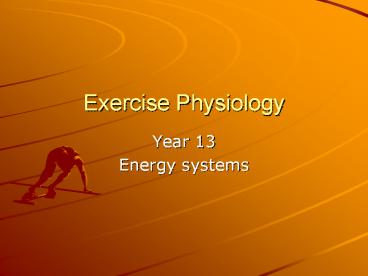Exercise Physiology - PowerPoint PPT Presentation
1 / 21
Title:
Exercise Physiology
Description:
Exercise Physiology Year 13 Energy systems Energy Energy for muscular contraction comes from the breakdown of ATP (adenosine tri phosphate) ATP breaks down in the ... – PowerPoint PPT presentation
Number of Views:44
Avg rating:3.0/5.0
Title: Exercise Physiology
1
Exercise Physiology
- Year 13
- Energy systems
2
Energy
- Energy for muscular contraction comes from the
breakdown of ATP (adenosine tri phosphate)
Molecule splits energy released
3
Muscle contraction
ADP why is it adp?
Energy
4
- ATP breaks down in the muscle cells where it
will be used - The body uses food for the creation of ATP
- the nutrients we extract from food are
- A)
- B)
- C)
5
Carbohydrates
- Broken down into glucose
- Stored as glycogen
- Bodys preferred source of ATP can be used with
an without oxygen
6
Carbohydrates
7
Fat
- Fats broken down into triglycerides or free
fatty acids - stored as Adipose
- Used to produce ATP
- during sub- maximal exercise
- Increase during aerobic exercise
8
FAT
9
Proteins
- Broken down into amino acids
- Used to create tissues
- Used to make ATP
- - in extreme physical endurance
10
PROTEIN
11
So.
- Nutrient use is dependant on the length and
intensity of the exercise being performed
12
ATP production
- At Rest
- ATP produced with oxygen
- - mix of carbs and fats
- What happens to the ?
- -CO2
- -H2O
- Whats this ATP used for ?
Oxygen
Glucose
Triglycerides
CO2 H20 Heat Energy
13
ATP production
- During Exercise
- ATP- CP system
- Occurs without oxygen - (anaerobically)
- energy for intense exercise, 0-10 seconds
- The stores of C-P replaced after 2 minutes of
rest
14
ATP production
- During Exercise contd
- Anaerobic glycolysis ( lactic acid system)
- Anaerobic w/o oxygen
- Glycolysis breakdown of glycogen
- 30-120 secs
- high to moderate intensity exercise
15
What sports would predominately use this energy
system??
Glycogen
Glucose
Pyruvic acid
NO oxygen
Lactic acid
Can not clear until rest lactic acid build
up fatigue Stop , pass out
16
ATP production
- During Exercise contd
- Aerobic glycolysis (aerobic system)
Glycogen
Glucose
Pyruvic acid
Sufficient oxygen
?
?
?
?
17
- Fats-- require more oxygen than carbohydrates to
produce the same amounts of energy - SOhow does our nutritional intake affect our
performance in - Everyday life , jobs, Hauora
- 10km run
- Activities with our mates
- Weekend sport
18
of energy contribution in exercise
ATP-CP ANAEROBIC AEROBIC EXAMPLES
100 0 0 JUMPS , THROWS
80 20 0 BASKETBALL, BASEBALL
60 20 20 SOCCER , TENNIS
40 50 10 1500 M , SLALOM SKIING
10 40 50 3000 M RUN , 800 M SWIM
5 15 80 10 KM
0 5 95 ROAD CYCLING, MARATHON
0 0 100 SHOOTING , BOWLS , DRIVING
? ? ?
19
- Energy systems in use
ATP-cp
Anaerobic
Aerobic
Duration of activity
20
- How would training affect the relationship
between the energy systems? - Systems will become more efficient
- -
- -
- Transitions between usage of each energy system
is quicker - -
- -
(Why does it take approx 2 mins before aerobic
system takes over as main energy system ? )
21
- Because it takes that long for the oxygen uptake
and delivery systems to provide enough oxygen
for aerobic glycolysis.












![READ[PDF] Laboratory Manual for Human Anatomy & Physiology with Cat & PowerPoint PPT Presentation](https://s3.amazonaws.com/images.powershow.com/10082843.th0.jpg?_=20240722027)


















